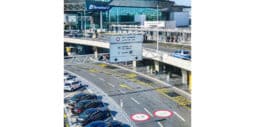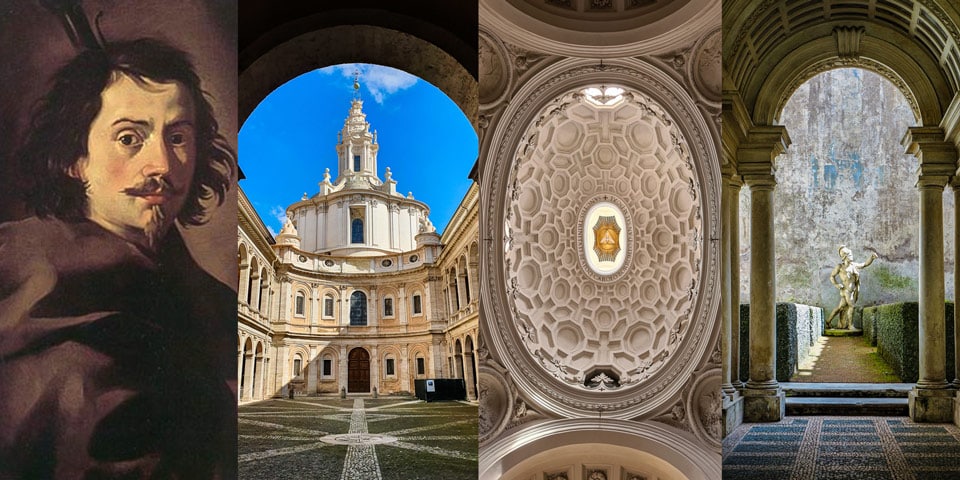

24828 views

Francesco Borromini was an expressive and irrational Baroque architect from Italy. He was the most prominent master of spatial construction solutions and the author of several buildings and many interior designs.This article describes where to see Borromini’s architecture in Rome.
Contents
ToggleFrancesco Borromini was born on September 25, 1599, in Ticino, an Italian-speaking canton in southern Switzerland. His real name is Castelli. Deciding to become a stonemason, Francesco continued the work of his father. As a young man, he became an apprentice stone carver in Lombardy. Then he goes to master the craft in Milan, and at the age of twenty, he is already working in Rome under the guidance of a relative Carlo Maderno.
At this time, Maderno led the construction of the Basilica of St. Peter (Sancti Petri) in the Vatican (Stato Della Città del Vaticano) and the Palazzo Barberini, so he was able to arrange a young man for a well-paid position.
Read also how to buy tickets to the Vatican Museums and Sistine Chapel
Michelangelo and Andrea Palladio influenced the architect to create his style. Moreover, the hallmark of Borromini was the use of waviness instead of circles, complemented by the waviness of architectural compositions. He preferred to work with petite forms rather than aiming for a large urban project. The favorite materials of the master were: brick, stone, gypsum, and plaster.
At the same time, Borromini preferred to break the lines, create unusual decor patterns, and highlight the works with a soft light.
When Borromini arrived in Rome, he was given an overview of the most significant construction projects there, including the Palazzo Barberini project, which Cardinal Maffeo Barberini, the future Pope Urban VIII, had commissioned. But after Maderno passed away and Bernini took over the projects, their rivalry grew bitterer, and it seems that Bernini didn’t even pay Borromini for his work on Saint Peter.
The most important biography of Borromini was written by 17th-century historian Filippo Baldinucci, who also said that the architect was a sober, serious individual with high principles. He loved his work and was envious of it significantly. He treated his projects and drawings as though they were his siblings, and before he passed away, he burned them all to prevent his enemies from wrongfully seizing them.
Although he had many friends, including well-known figures like Pope Innocent X Pamphilj, his avid supporter and protector, Borromini was known in Rome for being extremely timid and irritable.
The rivalry between Bernini and Borromini became so well-known that many rumors also began to spread in addition to the actual events. However, they have all been entirely disproved by historians. While Bernini was a skilled craftsman who succeeded in sculpture, painting, and architecture, Borromini was a brilliant architect who consistently performed, especially when the works and projects were challenging.
The church of San Carlo Alle Quattro Fontane, one of Borromini’s most well-known works in Rome, was finished by his nephew Bernardo three years after his uncle’s suicide in August 1667. Unfortunately, the Spanish Trinitarians who originally commissioned the church never agreed to host the body of a suicide victim, so, despite Borromini’s project, the small chapel in the local crypt that was reserved for him remained empty.
Borromini was buried in the church of San Giovanni dei Fiorentini, even though he had committed suicide.
Here’s the list of Borromini’s architectural places to visit in Rome:
Here is the map that you can follow to find all the Borromini sites in Rome. You can dedicate a day to studying his masterpieces by following the list of places below in a recommended sequence.
Recommended Itinerary for seeing the Architectural Masterpieces of Borromini in Rome:
I advise you to start your route from the Basilica of San Giovanni in Laterano, after which you can take the metro to Piazza Barberini, where you can start walking.
Before the Jubilee of 1650, Pope Innocent X Pamphilj hired Borromini to renovate the historic basilica of S. Giovanni in Laterano in 1646. Although Borromini would have preferred a complete overhaul of the church, he was hampered by several constraints imposed by the pontiff, including orders that the 16th-century gilded coffered ceiling and 15th-century floor were not to be touched.
So instead, Borromini focused on the aisles and central nave, changing them with new pillars, 12 enormous niches for apostle statues, and new three-dimensional paving in the four side naves.
This small church, which acted as Borromini’s first solo architectural project, was far superior to his contemporaries’ creations. An undulating façade compensated for the plot’s tiny, awkward shape. A conventional dome would be the obvious choice to unite the building’s two sides because the site is on a corner. Instead, Borromini unconventionally used a different form on each street, with tiers of decreasing size on one side and a small bell tower on the other.
Still more unexpected is the interior. There is an oval dome, after all. The deep coffering of the dome provides plenty of drama without the need for ornamentation or sculpture—mainly when interlocking crosses, hexagons, and octagons are used instead of the traditional squares.
Thanks to the collaboration of the top architects of the day like Carlo Maderno, Gian Lorenzo Bernini, and Francesco Borromini, the residence of the notable Barberini family, known as Barberini Palace (Palazzo Barberini), houses essential artworks created by the artists.
The magnificent helicoidal staircase, created by Borromini and situated to the right of the entryway, was made public for the first time in 2018. The Italian National Gallery of Ancient Art is located in the palace’s east wing, where Bernini created the quadrangular staircase of honor.
Palazzo di Propaganda Fide (Palace of the Propagation of the Faith) is right in the heart of Rome, halfway between the Spanish Steps and Piazza Barberini. One of the most outstanding examples of Baroque art in Rome, the Palazzo of Propaganda Fide, was started by Bernini and finished by Borromini in 1665.
Borromini was commissioned in 1653 to finish the 16th-century church of S. Andrea delle Fratte. However, his oval dome design was rejected. Borromini was also responsible for the apse and the square campanile which houses Bernini’s two Angels (1667-1670) with instruments of the Passion intended for Ponte S. Angelo but considered by Pope Clement XI too beautiful to remain exposed to the elements.
The church of S. Ivo alla Sapienza, a chapel of the former La Sapienza University of Rome, was created by Borromini between 1643 and 1660 but is rarely available to the public. The architect based his original geometric design on the cramped courtyard created by Giacomo della Porta in the 16th century. In addition to using concave and convex surfaces, Borromini’s designs also include decorative features related to the three popes who presided over the construction project:
Moreover, the dome of the church is especially remarkable.
Sant’Agnese in Agone, commonly known as Sant’Agnese in Piazza Navona, is a Rome Baroque church from the 17th century. It looks out over Piazza Navona, one of the principal public areas in the old part of the city and where the early Christian Saint Agnes was martyred in the Domitian Stadium. The work was designed by Girolamo Rainaldi and his son Carlo Rainaldi, who started construction in 1652. Francesco Borromini, the second key architect, became engaged after numerous debates.
With Gerhard Ludwig Müller acting as the current Cardinal-Deacon, the church has a titular deaconry. In addition to religious services, the church often presents classical performances in the Borromini Sacristy, varying from chamber music to operas and sacred Baroque works.
Eitch Borromini Palazzo Pamphilj is set in a historical building from the 17th century, designed by Francesco Borromini. It is a hotel boasting a panoramic terrace with views of Piazza Navona, St. Peter’s Basilica, and the Pantheon.
Beginning in 1654, Borromini created a square-based building with a strong verticalism that extended from Via Santa Maria dell’Anima to Via Sant’Agnese in Agone and overlooked Piazza Navona.
The current Hotel Eitch Borromini is a six-floor structure that is situated next to the sacristy of the Sant’Agnese in Agone church. It includes a stunning and atmospheric roof terrace that provides visitors with one of the most breathtaking views of Rome.
The Terrazza Borromini is located on the fourth floor next to the Art gallery and is open to visitors. The restaurant offers an unusual menu that draws inspiration from traditional Roman cuisine and uses the best ingredients available throughout Italy.
On the sixth floor, the elegant rooftop of Hotel Eitch Borromini is open for refined aperitifs and special events.
An intimate bar with a few sofas in a spectacular setting: a 360-degree view of the rooftops of Rome.
Rome is home to the Biblioteca Vallicelliana. The library is situated in Francesco Borromini’s Oratorio dei Filippini building on Piazza della Chiesa Nuova.
Manuscripts, incunabula, and books totaling over 130,000 volumes are kept in the library. In addition, there are over 3,000 Latin and Greek manuscripts, including an Alcuin-owned Bible from the ninth century and a lectionary from the 12th. Also, the library has books from the Reformation and Counter-Reformation eras.
Francesco Borromini remodeled the Palazzo Falconieri, a mansion in Rome, in the seventeenth century. Since its founding in 1927, it has served as the residence of the Hungarian Academy Rome, the Balassi Institute’s Rome office. It is close to Palazzo Farnese and a few buildings down and across Via Giulia from the church of Santa Caterina della Rota in the Rione of Regola. It is situated between Via Giulia and Lungotevere, with entrances to both. Napoleon’s uncle, cardinal Joseph Fesch, lived there starting in 1814.
Spada Gallery was briefly owned by the Mignanelli family until, in 1632, the palace was purchased by Cardinal Spada, who commissioned modifications from Francesco Borromini.
Borromini created a masterpiece of forced perspective optical illusion in the arcaded courtyard. There, diminishing rows of columns and a rising floor give the illusion of a gallery 37 meters long (8 meters in reality), with a life-size sculpture at the end of the vista, in daylight beyond. The statue is 60 cm high. A mathematician helped Borromini with his perspective technique.
With designs by Francesco Borromini, work on the church’s construction began in 1643. It was attached to an Augustinian nunnery that Camilla-Virginia Savelli Farnese, Duchess of Latera, had founded. However, the fortunes of the House of Farnese collapsed, and so did the church’s finances. By 1655 the work had ended.
The convent faced numerous difficulties in the nineteenth century, but unlike many other monasteries, it was not deconsecrated in 1873. The nunnery eventually faded away over time, and today the majority of the convent is the Hotel Donna Camilla Savelli.
Author: Kate Zusmann
This website uses cookies. For more info read the cookies policy
Rome.us © 2025. Created with love by Roman experts and guides.